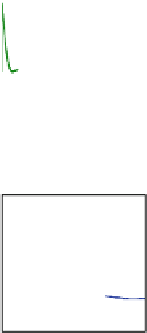Environmental Engineering Reference
In-Depth Information
Fig. 6.5 System outputs
and blade pitch angle, no
faults
Rotor speed
Blade 1 position
3
Full K
Diagonal K
2
Full K
Diagonal K
2
1
1
0
0
−1
−1
0
50
100
0
50
100
[Time]
[Time]
Generat
o
r speed
Blade 2
p
osition
300
Full K
Diagonal K
Full K
Diagonal K
0.5
200
100
0
0
−100
−0.5
0
50
100
0
50
100
[Time]
[Time]
Platform pitch position
Blade 3
p
osition
2
0.1
Full K
Diagonal K
Full K
Diagonal K
0.05
1
0
0
−0.05
−0.1
−1
0
50
100
0
50
100
[Time]
[Time]
K
diagonal
¼
diag
f
0
:
0470
;
0
:
0003
;
0
:
0042
g
:
ð
6
:
20
Þ
Simulation of the nonlinear model is carried out in MATLAB/Simulink inter-
faced with FAST. 27 DOFs are now available, counting the 24 DOFs from FAST
and the 3 DOFs extra from the pitch actuators. The input to the model is turbulent
wind, and the wind profile is obtained from the software Turbsim [
11
], which also
is a software developed at the NREL. The profile is a 1-year extreme case with an
average speed of 18 m/s and a turbulence intensity of 6 %, see Fig.
6.7
. Significant
wave height is 6 m with a peak wave period of 10 s. The time-series are of 600 s,
but the first 200 s are taken out due to transient behavior. The gain matrix in the
feedback loop is now constrained to have diagonal structure. A fault is introduced
to the system after 200 s. This fault causes sensor nr. 3 to stop working, i.e., blade
nr. 3 is not moving. This fault only happens to simulations with the constrained
controller, and not for the baseline simulation. It may be noted that the c-value is
considerably higher when the diagonal structure constraint is imposed. This makes
sense because the number of
LMI
variables have now decreased and there are a
lower number of variables available when it comes to finding the lowest c-value.






































































































































